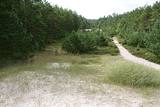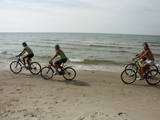| Nr | Nosaukums | Apraksts |
|---|---|---|
|
MIKO konditoreja pēc savām īpašajām receptēm gatavo vairāk kā 100 produkcijas veidus - kūkas, pīrāgus, eklērus, cepumus. Sākotnēji tas tika darīts Saldū, bet kopš 2016. gada - arī Liepājā. Visu piedāvāto kopā ar kafiju iespējams nobaudīt nelielajās kafejnīcas telpās, turpat var veikt pasūtījumus, saņemt īpaši gatavotu produkciju un aplūkot mākslinieces Diānas Krūmiņas gleznas. Tiek piedāvāta arī apkalpošana un galdu klāšana banketiem un citiem svinīgiem pasākumiem. |
||
|
Atrodas Talsu centrā. Iecienīta pusdienu maltīšu ieturēšanas vieta ar plašu latvisku ēdienkarti. |
||
|
Kafejnīca "Kukaburra" atrodas Rīgas - Veclaicenes šosejas (A2) 115. km. Iespējams apskatīt maizes muzeju un piedalīties maizes cepšanā, kas notiek katru nedēļas nogali. Latvisks interjers, mājražotāju un zemnieku produkti. |
||
|
Traķu pussalas pils austrumu mūrim pieguļ ar mežu apaudzis iespaidīgs pilskalns (uzved koka kāpnes) – t.s. Upurkalns, kurā pirms mūra pils celtniecības stāvējusi koka pils. 1779. g. dominikāņu mūki sagrautās Pussalas pils vietā uzsāka baznīcas celtniecību. Jau vēlāk – 1822. – 1823. g. vienā tās daļā uzcēla dominikāņu klosteri, bet otrā – kapelu. 1990. g. šeit izvietoja Traķu vēstures muzeja administrāciju, bet 2005. g. kapelā izveidoja Sakrālās mākslas izstādi. 2011. g. ēku kompleksā notika vērienīgi rekonstrukcijas darbi. |
||
|
Dodieties ekskursijā, lai gūtu ieskatu lauku profesijā un dzīvesveidā, kā arī iegūtu jaunus iespaidus un labu atpūtu visai klasei. Ekskursijas laikā apmeklējiet podnieku, kurš skolēniem māca, kā praktiski darboties ar rokām, kā no māla izveidot skaistu darbus ar saviem parakstiem un zīmējumiem. Pēc tam apmeklējiet maiznīcu, kur saimniece piedāvā maizes degustāciju un picu cepšanu. Ekskursijas noslēgumā dodieties uz agro saimniecību, lai redzētu, kā siltumnīcās tiek audzēti tomāti, izmantojot mūsdienīgas fotosintēzes tehnoloģijas. |
||
|
Valmieras pils celtniecību uzsāka 1283. gadā. Ziemeļu kara laikā (1702. g.) pili nodedzināja, bet 17. gs. beigās nojauca pilsētas ārējos mūrus. Saglabājušās pils drupas un citas viduslaiku nocietinājumu paliekas. |
||
|
Saimniece cep uz pasūtījuma dažādas kūkas, plātsmaizes, sklandraušus un pīrāgus ar dažādiem pildījumiem. Ir iespējams pasūtīt arī kūpinātas zivis. |
||
|
Restorāns "Brūzis" atrodas Smiltenes parkā – Abula ielejā un izvietots Kalnamuižas bijušajā alus brūzī. Blakus atrodas Smiltenes sidra darītava, tādēļ viesi var nobaudīt ābolu sidru un mājas vīnu, kas darināts no Latvijas ogām. Latviešu virtuve: Aukstā zupa, cūkgaļa ar sīpoliem, kartupeļu pankūkas, rudzu maizes kārtojums, auzu pārslas ar putukrējumu. Īpašais ēdiens: „Brūzis” – pildīts cūkgaļas veltnītis. |
||
|
Hāpsala kādzreiz bija aristokrātu iecienīta vieta, viņi mēdza šeit uzturēties vasaras laikā. Mūsdienās apmeklētājus vilina pilsētas šarms - mazās ieliņas, vecās koka ēkas un skaistā promenāde. Viens no iemesliem, kādēļ Hāpsala bija tik populāra kādreiz, bija SPA plašie piedāvājumi un iespējas, kas ir aktuāli arī mūsdienās. Interesants fakts: slavenajam komponistam Čaikovskim šī vieta bija viena no mīļākajām, kur pavadīt brīvdienas. |
||
|
Pie Lielauces muižas sākas laipu taka, kas pa purvaino (pārejas tipa purvs) Lielauces ezera krastu aizved līdz laivu novietnei pie ezera atklātās daļas. Var nomāt laivu un makšķerēt, jo zivju krājumi tiek regulāri atjaunoti. Atrodas Vīķu purva dabas liegumā. |
||
|
Saimniecībā žāvē cūkgaļu, taisa asinsdesas un ražo citus gaļas izstrādājumus. Saimnieks piedāvā ekskursiju un žāvējumu iegādi. |
||
|
Kiiu muižai piederošais tornis tika uzbūvēts 16. gs. pirmajā ceturksnī un kalpoja kā muižnieku „slēptuve”. Atvērts un piedāvā igauņu slavenā „Kiiu torn” liķieri. |
||
|
Tieši pie jūras, tikai 20 minūšu brauciena attālumā no Pärnu, atrodas Kapteiņa māja (Kapteni talu), kur kapteiņa svaigi nozvejotās zivis pārtop gardos zivju ēdienos, kurus var iegādāties vai nogaršot Kapteiņa vasaras kafejnīcā. |
||
|
Vienīgā baznīca nacionālā parka teritorijā. Tā atrodas Kirblas (Kirbla) ciemā – uz neliela pacēluma, kas Baltijas ledus ezera laikā bijusi sala, kuru no visām pusēm ietvēris ūdens. Kirblas baznīcas pirmsākumi ir meklējami 16. gs. un par tās celtniecību saglabājušies dažādi interesanti nostāsti. Tas ir viens no mazākajiem Igaunijas dievnamiem (29 x 11 m). |
||
|
Auto stāvlaukumā pie Kolkas raga priežu takas sākuma
acīgāks vērotājs pamanīs mūsdienās aizaugošu plašu stigu, kuras viens
gals beidzas jūras krastā, otrs – pie Kolkas – Ventspils ceļa. Šī vieta
padomju laikā tika izmantota militāriem mērķiem – šaušanas
apmācībām.
|
||
|
Atpūtas komplekss „Ezerkrasti” atrodas Latvijas otra lielākā – Rāznas ezera ziemeļu krastā. No kafejnīcas "Kastanis" logiem paveras viens no skaistākajiem Latvijas ezeru skatiem! Latviešu virtuve: zivju, skābeņu un aukstā zupa, miežu biezputra, pelēkie zirņi ar speķi, sautētas cūkgaļas ribiņas ar kāpostiem, zivju ēdieni, mājas sieri un pildīti āboli ar medu. Īpašais ēdiens: kartupeļu dračenka – sarīvēti un sacepti kartupeļi ar gaļu un sīpoliem. |
||
|
Sena un nozīmīga tirdzniecības un amatniecības centra vieta Rīgas HES ūdenskrātuves kreisajā krastā, kas virs Daugavas paceļas ap 15 m augstumā. Uzskata, ka pie mazā strauta - Varžupītes ietekas blakus Daugmales pilskalnam - atradusies vēstures dokumentos pieminētā Zemgales osta. Pēc atrastajām senlietām var spriest, ka pilskalns un tā piekāje ar senpilsētu bijis apdzīvots līdz 12. gs. beigām, kad Daugmales nozīmi mazināja strauji augošā Rīga. Pilskalna piekāje ir nostiprināta. |
||
|
Saimniecības "Toomemäe" mājas restorānā "Maagõkõnõ" pasniedz vieglu ēdienu ar tīru garšu, kas vēl vecmāmiņu laikos bija ikdiena, bet tagad tiek uzskatīts par gardēžu privilēģiju. Tiek pasniegti tieši šai pusei senāk raksturīgie ēdieni. Izejvielas ir tīras un no tuvākās apkārtnes. |
||
|
Aizsargājamā jūras teritorija „Nida - Pērkone” ir viena no bioloģiski daudzveidīgākajām un dabas aizsardzībai nozīmīgākajām jūras teritorijām Baltijas jūras atklātās daļas piekrastē – šeit atrodamas izcilākās rifu teritorijas. Migrācijas laikā teritoriju šķērso vairums Latvijā sastopamo migrējošo putnu sugu. Teritorija īpaši nozīmīga lielās gauras un mazā ķīra aizsardzībai. Tā atrodas iepretim Rucavas un Nīcas novadam, platība - 36 703 ha. Teritorija daļēji pārklājas ar dabas parka „Pape” jūras daļu un ietver dabas parka „Bernāti” jūras daļu.
|
||
|
Cirma ezera rietumu krastā slejas 1830. g. no laukakmeņiem būvētā baznīca. Tā ir slavena ar Jaunavas Marijas gleznu, kam piedēvē brīnumdarītājas spējas. Šī iemesla dēļ dievnams ir populārs svētceļnieku galamērķis. |
||

















